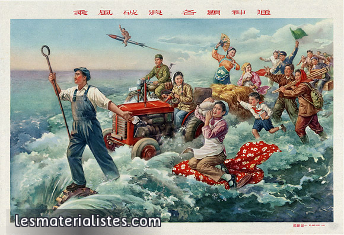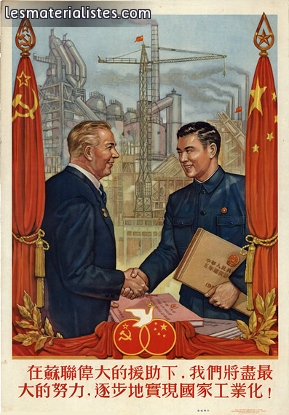Chinese people's communes - 3 : The first successes
Submitted by Anonyme (non vérifié)
During the period 1945-1949, the People's Liberation army, composed of 1.2 million officers and soldiers, had to face the Guomindang and its 4.3 million troops, which had the support of US imperialism: 50 000 Marines guarded strategic sites, whereas 100 000 others in the coastal province of Shandong, equipment and training and even transportation were furnished to 500 000 troops.
But the ability to mobilize the masses according the communist ideology – the people's war – was the key to success. During the decisive Battle of Hsupeng, the 800 000 troops of the Guomindag faced only 660 000 troops of the People's Liberation Army, but also 600 000 irregulars and 5,3 million of people helping.

In this context, in 1949 with the victory on all the Chinese mainland, the situation was very difficult. There was inflation, food shortages, but also a lack of transport and communication. The railway links, for example, were destroyed. China didn't even have a meteorological service or bicycles factories. This was not only because of the war: the backward situation of China aggravated the problems.
Because of this, the first task of the Communist Party of China was to implement the agrarian revolution, and the landlords saw their lands given to the masses. This was a part of the New Democratic Revolution which established the people's courts at all levels of jurisdiction, and therefore judged and condemned landlords.

The New Democratic state also promoted peasant associations, tool-making and handicraft enterprises, local militias and new irrigation systems, so that the new form could triumph over the old one. From 1953 onwards, the state promoted cooperative farms, with the common use of fertilizers, seeds and equipment. In 1957 already, 90% of the farmers were in cooperatives.
But breaking the fundamental basis of the imperialist penetration was of course not enough. Therefore, in the cities, the comprador bourgeoisie acting as the lackeys of imperialism, saw its companies confiscated by the state. The national bourgeoisie, who was very weak, could continue to produce and sell its merchandises, but with a regulation of the prices, the wages, the working conditions.
The banking system was nationalized and put under control of the People's Bank of China. Therefore in 1952, the inflation was under control again, there was a new solid currency called the “yuan”, and the capitalist sector only made up 17% of the total. Between 1949 and 1957, food production doubled. Basically, in the first five years after 1949, the average annual increase rate of the national income reached 9%.

A major role here was the one of the USSR. 700 development projects were created, staff was sent from the USSR, whereas Chinese students went to learn in the USSR. 219 industrial plants were completely set up by the USSR: steel mills, oil refineries, plane and truck factories, power stations.
The USSR also provided blueprints for others factories, designed thousands of machinery and other equipment, helped organize and manage the production, etc. A first five year plan was organized in 1953, notably to develop a strong industry in the fields of steel, chemicals and coal.
Between 1952 and 1957, the production in million tons went from 64 to 124 for coal, 1,9 to 5,86 for pig-iron, 1,35 to 5,24 for steel, 194 to 740 for chemical fertilizer, 0,44 to 2 for crude oil. The number of machine tools went from 13 734 to 80 000, and electrical power, in thousand million kw, from 7,26 to 19,1.
The Communist Party of China also launched several campaigns to support the movement. One of them, in 1951, was the “Three Antis”: anti-corruption, anti-waste, and anti-bureaucracy, another in 1952 was the “Five Antis”: anti-bribery, anti-theft of state property, anti-tax evasion, anti-cheating on government contracts, and anti-stealing state economic information.

The New marriage law, passed as soon as 1950, also permitted the women to enjoy the same rights as men, under the slogan “Men and women are equal; everyone is worth his (or her) salt”.
In 1954, it was thus possible to produce the first constitution of the People's Republic of China.
Nevertheless, contradictions in the country had reached new levels. An important answer in 1955 was the “Directive on launching a struggle to cleanse out hidden counter-revolutionary elements”, purging the Party and the State from opportunistic elements coming from the Guomindang, the landlords or the intellectuals.
To continue this movement against bureaucracy, the Party launched, in april 1956, the Hundred Flowers campaign. Mao Zedong theorized the principle in 1957 in his famous document called “On the Correct Handling of the Contradictions Among the People”.
Accordingto Mao Zedong, there was a lack of understanding of how the contradictions could be different and so resolved differently. He explained that:
“The contradictions between ourselves and the enemy are antagonistic contradictions. Within the ranks of the people, the contradictions among the working people are non-antagonistic, while those between the exploited and the exploiting classes have a non-antagonistic as well as an antagonistic aspect (…).
"Let a hundred flowers blossom, let a hundred schools of thought contend" and "long-term coexistence and mutual supervision"--how did these slogans come to be put forward? They were put forward in the light of China's specific conditions, in recognition of the continued existence of various kinds of contradictions in socialist society and in response to the country's urgent need to speed up its economic and cultural development.
Letting a hundred flowers blossom and a hundred schools of thought contend is the policy for promoting progress in the arts and sciences and a flourishing socialist culture in our land. Different forms and styles in art should develop freely and different schools in science should contend freely.
We think that it is harmful to the growth of art and science if administrative measures are used to impose one particular style of art or school of thought and to ban another. Questions of right and wrong in the arts and science should be settled through free discussion in artistic and scientific circles and through practical work in these fields.
They should not be settled in an over-simple manner. A period of trial is often needed to determine whether something is right or wrong. Throughout history at the outset new and correct things often failed to win recognition from the majority of people and had to develop by twists and turns through struggle.
Often, correct and good things were first regarded not as fragrant flowers but as poisonous weeds. Copernicus' theory of the solar system and Darwin's theory of evolution were once dismissed as erroneous and had to win out over bitter opposition.
Chinese history offers many similar examples. In a socialist society, the conditions for the growth of the new are radically different from and far superior to those in the old society. Nevertheless, it often happens that new, rising forces are held back and sound ideas stifled.
Besides even in the absence of their deliberate suppression, the growth of new things may be hindered simply through lack of discernment. It is therefore necessary to be careful about questions of right and wrong in the arts and sciences, to encourage free discussion and avoid hasty conclusions We believe that such an attitude will help ensure a relatively smooth development of the arts and sciences (…).
It is inevitable that the bourgeoisie and petty bourgeoisie will give expression to their own ideologies. It is inevitable that they will stubbornly assert themselves on political and ideological questions by every possible means. You cannot expect them to do otherwise. We should not use the method of suppression and prevent them from expressing themselves, but should allow them to do so and at the same time argue with them and direct appropriate criticism at them.
Undoubtedly, we must criticize wrong ideas of every description. It certainly would not be right to refrain from criticism, look on while wrong ideas spread unchecked and allow them to dominate the field. Mistakes must be criticized and poisonous weeds fought wherever they crop up.
However, such criticism should not be dogmatic, and the metaphysical method should not be used, but instead the effort should be made to apply the dialectical method. What is needed is scientific analysis and convincing argument.
Dogmatic criticism settles nothing. We are against poisonous weeds of whatever kind, but eve must carefully distinguish between what is really a poisonous weed and what is really a fragrant flower. Together with the masses of the people, we must learn to differentiate carefully between the two and use correct methods to fight the poisonous weeds.”
